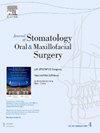肥胖者唾液细菌群的菌群失调和相互作用:一项人体横断面研究。
IF 1.8
3区 医学
Q2 DENTISTRY, ORAL SURGERY & MEDICINE
Journal of Stomatology Oral and Maxillofacial Surgery
Pub Date : 2024-11-14
DOI:10.1016/j.jormas.2024.102131
引用次数: 0
摘要
引言肥胖症的发病率在全球范围内持续上升,有可能引发各种严重疾病。肥胖症的发病机制十分复杂,最近的研究表明肥胖症与口腔微生物组之间存在联系,但具体机制仍不清楚:我们收集了 9 名非肥胖者和 13 名肥胖者的唾液样本,并进行了 16S rRNA 测序,以分析肥胖者和非肥胖者口腔微生物群在微生物丰度、功能和相互作用网络方面的差异:结果:与非肥胖者相比,肥胖者口腔唾液微生物群的组成截然不同,检测到的 ASV 数量更多,α 多样性指数更高。具体来说,嗜血杆菌、聚集杆菌和放线菌明显增多,而放线菌则明显减少。功能预测分析表明,肥胖组的生物膜形成途径明显更多。随机森林回归模型分析表明,Bergeyella 是最有贡献的菌属,而相互作用网络分析表明,Bergeyella 可能起到桥梁节点的作用,将肥胖组富集的菌属与更广泛的微生物群落联系起来,促进信息和资源的交流:讨论:我们的研究表明,肥胖可能与唾液微生物群的菌群失调和功能变化密切相关。要阐明肥胖与口腔微生物群失调之间的因果关系和潜在的分子机制,或确定它们是否相互影响,还需要进一步的研究。本文章由计算机程序翻译,如有差异,请以英文原文为准。
Dysbiosis and interactions of the salivary bacteriome in obese individuals: A human cross-sectional study
Introduction
The prevalence of obesity is continually rising worldwide, posing a risk for the development of various serious diseases. The pathogenesis of obesity is complex and recent research suggests a link between obesity and the oral microbiome, though the specific mechanisms remain unclear.
Material and methods
We collected saliva samples from 9 non-obese and 13 obese participants and conducted 16S rRNA sequencing to analyze the differences in oral microbiota between obese and non-obese individuals in terms of microbial abundance, functionality, and interaction networks.
Results
Obese participants exhibited a distinct composition of salivary microbiota compared to non-obese participants, with a greater number of ASVs detected and higher α diversity indices. Specifically, Haemophilus, Aggregatibacter, and Actinobacillus were significantly enriched, while Actinomyces showed significant depletion. Functional prediction analysis indicated that biofilm formation pathways were significantly more abundant in the obese group. Random forest regression model analysis identified Bergeyella as the most contributive genus, and interaction network analysis suggested that Bergeyella may function as a bridge node, linking the obese group-enriched genera to the broader microbial community and facilitating the exchange of information and resources.
Discussion
Our study suggests that obesity may be closely associated with salivary microbiota dysbiosis and functional changes. Further research is needed to elucidate the causal relationship and underlying molecular mechanisms between obesity and oral microbiota dysbiosis, or to determine if they mutually influence each other.
求助全文
通过发布文献求助,成功后即可免费获取论文全文。
去求助
来源期刊

Journal of Stomatology Oral and Maxillofacial Surgery
Surgery, Dentistry, Oral Surgery and Medicine, Otorhinolaryngology and Facial Plastic Surgery
CiteScore
2.30
自引率
9.10%
发文量
0
审稿时长
23 days
 求助内容:
求助内容: 应助结果提醒方式:
应助结果提醒方式:


